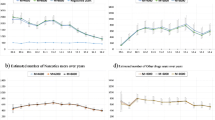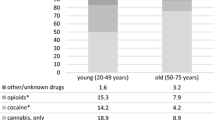Abstract
One of the objectives of Amsterdam's methadone maintenance treatment is maximising its coverage among problematic opiate users. In order to evaluate what proportion is reached, the capture–recapture method is conducted to estimate the prevalence of problematic opiate use. Samples of opiate users in contact with police, hospital or treatment are used. The treatment sample is limited to the low threshold treatment sample (treatment with minimal requirements to the clients). Based on differences of log likelihood ratio, Akaike's and Bayesian information criteria, log linear models are selected. The size of the population of problematic opiate users in 1997 is estimated to be 4130 (95% confidence interval: 3753–4566). Within 3 months 50% was registered: 16% at the police, 2.5% at the hospital and 40% at treatment. This study shows that the Amsterdam methadone treatment programs succeed in reaching a high proportion of problematic opiate users. The estimation of the prevalence of problematic opiate users is considered to be valid. However, if, instead of the low threshold treatment, the total treatment sample had been used, the population of interest and the sampled population would not match correctly, and prevalence would have been overestimated.
Similar content being viewed by others
References
Plomp HN, Van der Hek H, Adèr HJ. The Amsterdam methadone dispensing circuit: Genesis and e.ectiveness of a public health model for local drug policy. Addiction 1996; 91: 711–721.
Langendam MW, van haastrecht HJA, van Brussel GHA, et al. Differentiation in the Amsterdam methadone dispensing circuit: Determinants of methadone dosage and site of methadone prescription. Addiction 1998; 93: 61–72.
van Brussel GHA. Methadone treatment in Amsterdam: The critical role of general practitioners. Addict Res 1996; 3: 363–368.
EMCDDA report CT.97.EP.05, Scientific Review of literature on estimating the prevalence of Drug Misuse on the local level; Lisbon, 1999.
Korf DJ, Reijneveld SA, Toet J. Estimating the number of heroin users, a review of methods and empirical-findings from the Netherlands. Int J Addict 1994; 29: 1393–1417.
van Brussel GHA, Buster MCA. Care for the future, opiate addicts in Amsterdam, trends and figures 1996– 1998. GG&GD Amsterdam, Amsterdam, 1999.
International Working Group for Disease Monitoring and Forecasting, Capture–recapture and Multiple-Record Systems estimation I: History and theoretical development. Am J Epidemiol 1995; 142: 1047–1058.
Frischer M, Leyland A, Cormack R, et al. Estimating the population prevalence of injecting drug use and infection with human immunodeficiency virus among injection drug users in Glasgow, Scotland. Am J of Epidemiol 1993; 138: 170–181.
Salvany AD, Hartnoll R, Maguire A, et al. Analytical considerations in the use of capture–recapture to estimate prevalence: Case studies of the estimation of opiate use in the metropolitan area of Barcelona, Spain. Am J Epidemiol 1998; 148: 732–740.
Larson A, Bammer G. Why? Who? How? Estimating numbers of illicit drug users: Lessons from a case study from the Australian Capital Territory, Aust NZ J Publ Health 1996; 20: 493–499.
Buning E, van Brussel GHA. The effects of harm reduction in Amsterdam. European Addict Res 1995; 1: 92–98.
European Monitoring Centre for Drugs and Drug Addiction (EMCDDA). Methodological Guidelines to Estimate the Prevalence of Problem Drug Use on the Local Level. EMCDDA, Lisbon, 1998.
Hickman M, Cox S, Harvey J, et al. Estimating the prevalence of problem drug use in inner London: A discussion of three capture–recapture studies. Addiction 1999; 11: 1653–1662.
Woodward JA, Retka RL, Ng L. Construct validity of heroin abuse estimators. Int. J Addict 1984; 10: 93–111.
Hook EB, Regal RR. Validity of methods for model selection, weighting for model uncertainty and small sample adjustment in capture recapture estimation. Am J Epidemiol 1997; 145: 1138–1144.
National Consensus Development Panel on effective Medical Treatment of Opiate Addiction, Effective Medical Treatment of Opiate Addiction. JAMA 1998; 280: 1936–1943.
Author information
Authors and Affiliations
Rights and permissions
About this article
Cite this article
Buster, M., van Brussel, G. & van den Brink, W. Estimating the number of opiate users in Amsterdam by capture–recapture: The importance of case definition. Eur J Epidemiol 17, 935–942 (2001). https://doi.org/10.1023/A:1016256929862
Issue Date:
DOI: https://doi.org/10.1023/A:1016256929862




